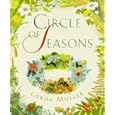Anyway, I started this week by showing a display we have here at the library that shows the solar system and talked about how all the planets go around the sun. Most of them could pick out which one was Earth, and several already knew that the sun was a star. We all sang "Twinkle Twinkle Little Star" then as a transition to our books.
Book 1: The Little Star by Deborah Nash
We started off this with this reader about a star that wants to live on Earth. The moon then gives him a tour of things in the sky and he decides to stay. At the end, a boy says he wants to live in the sky instead of on Earth. A simple story, but I do have a little problem with it that there's not a distinction between "sky" and "space", so the moon & star bounce on clouds and also roast hot dogs by the sun. Even some of the preschoolers notice that clouds and rainbows are not what we find in space. I did like the way it ended, because then I asked them questions like "Where do boys live?" "Earth" "Where does the sun live?" "Space".
Book 2: Night Goes By by Kate Spohn
Another book that didn't quite get at what I wanted to cover, but it was a nice soft story about the sun and moon (and star) taking turns in the sky. Loved the illustrations, and the soft colors and minimal text made me think about using this one for a bedtime book some time.
Book 3: My Place in Space by Robin & Sally Hirst
I kept this one for my Kindergarten group as it was too in-depth for my younger ones. A neat story about a young boy Henry and his sister getting on a bus and the bus driver getting quite an education when he patronizingly asks them if they know where they live. Henry goes into a detailed explanation of city, country, planet, solar system, galaxy, supercluster, and universe. Lots of neat facts about just how big space is, and this is a book that would only get more interesting with more readings.
Activity: Magic Stars
I found this one on the DLTK Kids' site. I laid down white paper on our tables and drew stars, moons, and planets all over them with white crayon. Then we painted over the paper with diluted tempera paint (washable paint, of course). My black paint was almost gone, so I mixed it with blue, and it turned a beautiful midnight blue color. The kids loved making it "turn from day to night" and find all the stars. I don't think there was any white space left at the end of any session - the kids probably would have painted longer if they had more paper. I think we may use this project again this summer when we do an ocean theme - I'll take some time to draw fish and other sea creatures for them to "find" next time!
This theme was used the week of February 22, 2010.
Next week: Pigs!













